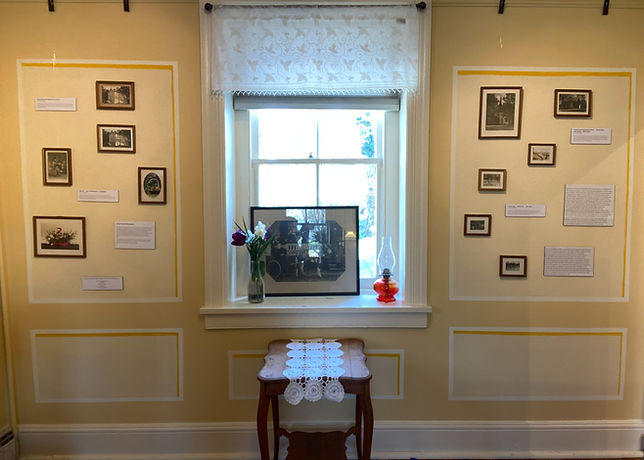
The Jones Sisters
During the early to mid-1900s, the Jones Sisters of Sykesville, MD found success in hand-coloring photographs of local sites and scenes. While Ida Jones attended The Maryland Institue College of Art, Elsie, the youngest of the three sisters, often took the lead in photography and art and did the majority of the painting. Regardless, the sisters considered each of the pieces to be the product of equal group effort and shared the credit. Often referred to as the ‘chauffeur’ by Elsie, Ida took the lead on transportation, photo development, and helped with the photography. Fannie, endearingly called the ‘nursemaid’ by Elsie, took care of the sisters during photography trips and wrote brief histories for some of the works. Elsie derived great joy from both taking and painting photographs by hand without any reliance on mass-produced techniques. Inspired by her love of history, she focused on places in Maryland as the subject of the photographs. For instance, one of the most famous collections, The Husker Works, pictured workers farming one of Fairhaven Farm’s several fields located at the intersection of 26 and 32. From the 1930s to 1950s, the sisters’ work gained popularity as wedding and birthday gifts. From 1954 to 1964, supported by strong local patronage, the sisters sold hand-painted photography at the Sunnie Holme Studio on Main Street. Along with hand-colored photographs, the sisters sold needlework, Christmas cards, and gave community talks on some photographs at the studio. Later in the sisters’ careers, they began to do still lifes with flower arrangements picked from their garden and received commissions to do a handful of portrait photos. Despite a primarily local influence, the sisters left a mark on the community with beautiful artwork and “‘Spurred’ women's liberation movement in South Carroll district”. A tightly knit trio, the Jones Sisters of Sykesville, MD never married and focused on art.
Want to Learn More?
Who Are They?
The Gate House Museum is home to a large collection of hand colored photographs by the Jones Sisters. The exhibit displays several of these along with photographs of the sisters, a book collection of their favorite photographs, a video on the hand coloring photography process, and a coloring station for visitors to create art just like the Jones sisters. This exhibit will be open to visitors until the end of August, 2022.
The Jones Sister Exhibit

Forbidden Love?
All three of the Jones Sisters notably never married over the course of their lives. A life without marriage, however, did not denote to a life without love. An oral interview conducted in 1998 by prior Gate House curator, James Purman, mentioned that for much of the early to mid 1900s, Elsie was seeing a man by the name of Lou Forster. The interview focused on what Forster's nephew, Louis Forster remembered about his time in Sykesville and the Jones sister. The younger Forster said that his Uncle Lou met Elsie during WWI while volunteering at the B&O railroad station during the war. The two were shared a common interest in photography, and the younger Forster remembers visiting Sykesville with his uncle often during his childhood to visit the Jones sisters. Beyond this, not much is known about Lou and Elsie, why they never married, or if their courtship concluded.

Guagenti, Toni. "Sisters Captured History: Farm Museum Exhibits Photos." Carroll County Times [Carroll County, MD], 23, Oct. 1992, p. A14.
A Cornerstone of the Community
As one of the wealthier families in Sykesville, the Jones found their own ways to give back to the community. For instance, the Jones sisters ran a rental library in their home for members of the community. Along with the library, the sisters also ran the Sunny Holmes studio, selling paintings, patchwork, and photographs for local patrons.

Hand Colored Photography
Hand-colored photography found popularity after the development of the camera. Despite the art form’s development in the 1860s (A Short History of Colour Photography 2020), colorized photography gained little traction as an art form until the 1970’s due to the cost of production, unstable pigmentation, and stigma as a medium often used by novice photographers a the time (Gern 2010). Initially, hand colored-photography faced criticism for being a ‘hybrid’ artform (Dawn's Early Light- the First 50 Years of American Photography 2010). Regardless, public demand for color outshone any complaints since “the lack of color in an otherwise “highly realistic medium” [ ] proved to be a disappointment” (Bibliography—Early Photography of Japan—Harvard College Library n.d). Some of the most popular examples of this can be viewed in the well-known Currier and Ives prints, which circulated in the American art world from the mid-1850s until around 1907 (Currier & Ives Frequently Asked Questions n.d). While this art form mostly faded from the artistic mainstream, many artists still use this technique to encapsulate both the personal and historical aspects of hand coloring images.
